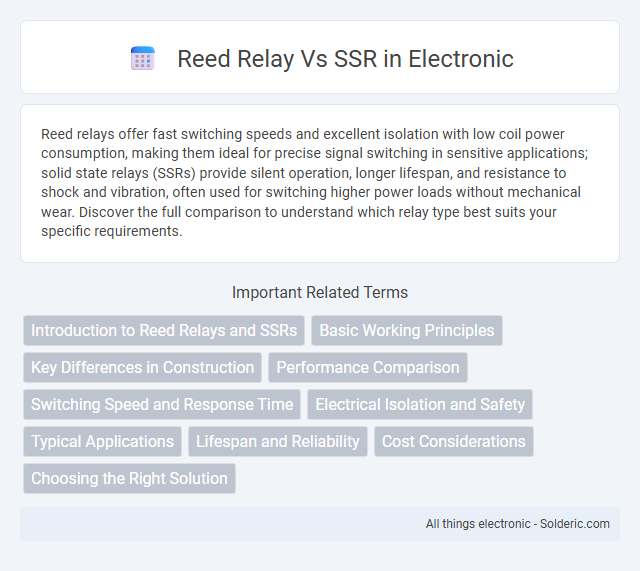Reed relays offer fast switching speeds and excellent isolation with low coil power consumption, making them ideal for precise signal switching in sensitive applications; solid state relays (SSRs) provide silent operation, longer lifespan, and resistance to shock and vibration, often used for switching higher power loads without mechanical wear. Discover the full comparison to understand which relay type best suits your specific requirements.
Comparison Table
| Feature | Reed Relay | Solid State Relay (SSR) |
|---|---|---|
| Switching Mechanism | Electromechanical with reed contacts | Semiconductor-based switching |
| Response Time | 1-3 ms (slower) | Less than 1 ms (faster) |
| Contact Life | Up to 10 million cycles | Up to 100 million cycles or more |
| Switching Noise | Audible click (mechanical noise) | Silent operation |
| Voltage & Current Ratings | Typically up to 200V, 1-10A | Ranges up to 600V, 50A+ |
| Power Consumption | Coil requires current to activate | Low input power, optocoupler control |
| Isolation | Physical contact isolates circuits | Optical isolation in input-output |
| Applications | Signal switching, telecom, instrumentation | Industrial control, heating, motor drives |
| Cost | Generally lower cost | Generally higher cost |
Introduction to Reed Relays and SSRs
Reed relays utilize magnetic reeds sealed in a glass tube that close contacts when an electromagnetic coil is energized, offering fast switching and low contact resistance ideal for precision applications. Solid State Relays (SSRs) employ semiconductor components like thyristors or triacs to switch loads without mechanical parts, enabling silent operation and longer lifespan under high-frequency switching. Both devices serve as electrical switches but differ fundamentally in construction, switching speed, reliability, and typical use cases across industrial automation, instrumentation, and control systems.
Basic Working Principles
Reed relays operate using a magnetic field to physically close or open contacts made of thin, flexible metal reeds within a sealed glass envelope, providing low contact resistance and fast switching for low-current signals. Solid State Relays (SSRs) use semiconductor components such as thyristors, triacs, or transistors to switch electrical loads electronically without moving parts, delivering silent operation and high reliability under high switching frequencies. Your choice depends on the need for mechanical isolation and the type of load, as reed relays suit sensitive signal applications while SSRs excel in industrial power switching.
Key Differences in Construction
Reed relays use magnetic reed switches enclosed in a glass tube, where thin metal reeds close or open the circuit when a magnetic field is applied. SSRs (Solid State Relays) rely on semiconductor components such as thyristors, triacs, or transistors to switch electrical loads without moving parts. Your choice between Reed relays and SSRs depends on desired switching speed, mechanical durability, and load type, as their fundamental construction impacts performance and lifespan.
Performance Comparison
Reed relays offer faster switching speeds and lower contact resistance compared to solid-state relays (SSR), making them ideal for high-precision, low-current applications. SSRs excel in durability and noise immunity due to their semiconductor construction, providing longer operational life without mechanical wear. The choice between reed relays and SSRs depends on the specific performance requirements, such as switching speed, contact longevity, and signal integrity.
Switching Speed and Response Time
Reed relays offer faster switching speeds and response times compared to Solid State Relays (SSRs) due to their mechanical contacts closing in microseconds, typically around 0.5 to 2 milliseconds. SSRs, relying on semiconductor switching, generally have response times ranging from 1 to 10 milliseconds, which can introduce slight delays in high-speed applications. Your choice between the two should consider these timing characteristics to ensure optimal performance in time-sensitive electronic circuits.
Electrical Isolation and Safety
Reed relays provide excellent electrical isolation due to their hermetically sealed contacts, ensuring minimal signal interference and high dielectric strength, which enhances overall safety in sensitive applications. Solid State Relays (SSRs) offer isolation through optocouplers or transformers but can exhibit leakage currents, potentially compromising safety in certain high-voltage environments. The choice between reed relays and SSRs significantly depends on the required isolation level and safety standards in the electrical system design.
Typical Applications
Reed relays are commonly used in low-level signal switching, test equipment, and telecommunications due to their fast response time and excellent isolation. Solid State Relays (SSRs) are preferred in industrial automation, motor control, and heating systems because of their durability, silent operation, and ability to handle high current loads. Your choice between these relays depends on the specific application requirements such as switching speed, electrical isolation, and load capacity.
Lifespan and Reliability
Reed relays generally offer a longer mechanical lifespan, often exceeding 10 million operations due to their simple, hermetically sealed contacts that resist contamination, enhancing reliability in low current applications. Solid State Relays (SSR) provide superior reliability for high-frequency switching and harsh environments, with no moving parts to wear out, but their lifespan is limited by thermal stress and semiconductor degradation, typically ranging from 100,000 to several million cycles depending on the load. Your choice between reed relay and SSR should consider the operational environment and expected switching frequency to maximize lifespan and maintain reliable performance.
Cost Considerations
Reed relays typically incur lower initial costs compared to solid-state relays (SSRs) due to simpler construction and fewer semiconductor components. SSRs, while having higher upfront expenses, offer longer lifespans and reduced maintenance costs, which can offset the initial investment over time. Evaluating total cost of ownership involves analyzing application-specific switching frequency, load type, and reliability requirements.
Choosing the Right Solution
Choosing between a Reed relay and a Solid-State Relay (SSR) depends on factors such as switching speed, load type, and isolation requirements. Reed relays offer low contact resistance and minimal electromagnetic interference, making them ideal for sensitive signal switching and low current applications. SSRs excel in handling high voltage and current with longer lifespan and faster switching, suitable for industrial automation and heavy-duty loads.
Reed relay vs SSR Infographic

 solderic.com
solderic.com